
Satyajit Gantayat
Satyajit has broad and deep experience in Agile coaching at the strategic senior executive level wh... Read more
![]() Get Your AI-Enabled Scrum Master Certification for Just ₹1,500 (Save 85%)!
Get Your AI-Enabled Scrum Master Certification for Just ₹1,500 (Save 85%)!
Scrum.Org
SAFe®
ICAgile
Scrum Alliance
Technical Agility
Kanban
Business Analysis
Project Management
AI-Enabled
Scrum.Org
SAFe®
ICAgile
Scrum Alliance
Technical Agility
Kanban
Business Analysis
Project Management
AI-Enabled

Satyajit Gantayat
Satyajit has broad and deep experience in Agile coaching at the strategic senior executive level wh... Read more

A value stream is the set of actions that add value to a customer from the initial request through the realization of value by the customer. The value stream begins with the initial concept, moves through various stages of development and on through delivery and support.
So, what is value? Value is something the customer can benefit from, like a product or a service of high quality received within an expected time & budget. And value is what your customers are willing to pay for.
Think of a value stream as a product line. For example, you see a demand for face masks in the market. People want masks that are safer and are aesthetically designed.
Here is a simplistic Value Stream for our example.

Become a certified SAFe Agilist and lead your organization toward success in today's dynamic business landscape. Join us and embark on a journey of professional growth and transformation.
Register Today
The start-up companies do not start as large, complex organizations. Rather, they usually start as a fast-moving, adaptive network of self-motivated individuals aligned to a common vision and focused on their customers’ needs. Roles and reporting relationships are smooth, and people collaborate seamlessly to identify customer needs, explore potential solutions, and deliver value in any way they can.
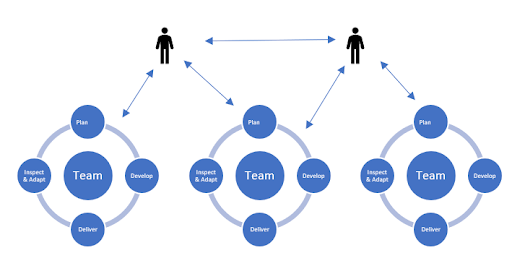
As the enterprise succeeds, it wants to expand on its success and grow. This means we hire more people, create more positions, define individual responsibilities, etc. To add expertise, additional specialists are hired. Additional departments are created. Additional managerial positions are created. New policies and procedures are established.
This kind of hierarchy model is created.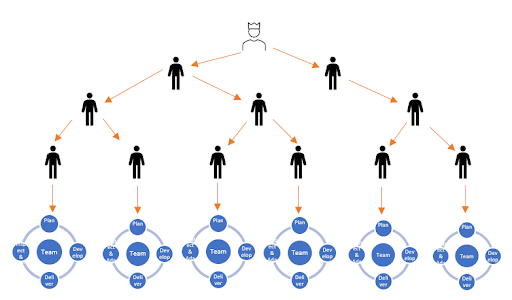 And what happens now?
And what happens now?
The business starts to organize by functions. To accomplish increasing economies of scale, the hierarchy continues to grow. And with that, we have a complex hierarchy where executives and managers start managing everything. And silos begin to form. Customer centricity becomes the casualty.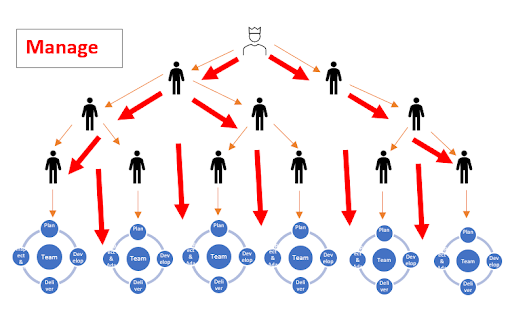
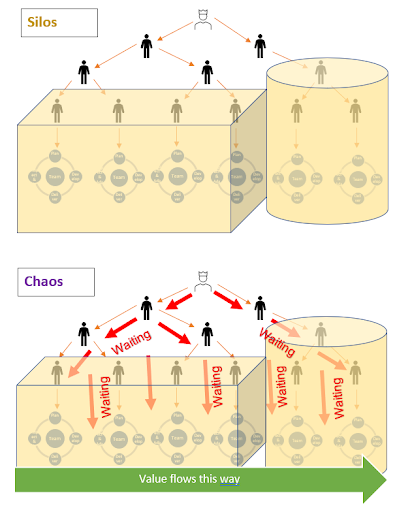
The network, which was once fast-moving and adaptive, is no more agile. Wastes are introduced in the forms of:
The age-old method of hierarchy in the organization does not seem to work now.
So, what is to be done?
We must re-organize around value streams instead of departments.
Align your organization where the value is. We still need the hierarchy system that drives the current revenue model that provides the required efficiency and stability and sells and maintains their products and services. But we need to re-organize to bring that Agility back. The focus is still on providing the customer with new solutions that address emerging opportunities and problems. And the organization is still nimble, adaptable, and vale stream-based.
Identifying Value Stream: It is important to identify and know the organization’s value stream before you could start thinking of optimizing it. Only when you identify the value stream, you could plan to organize around it. Everyone involved in the process is aligned to the value stream, and there is a clear alignment between Business and Technology. They both have the same goal.
Value Stream Mapping is a different concept and a powerful tool that is about enabling to see how value moves in an established value stream, where is the waiting time, where is the bottleneck, how to optimize the value stream, etc. We will talk about Value Stream Mapping in a different article.
There are two types of value streams: operational value stream and development value stream.
Here is an example of an operation value stream. It looks simple, isn’t it? But, in reality, it is quite hard to identify the value streams in a developing organization. It is not always obvious for a person working in the billing counter to identify and understand the entire value stream of how the customers are awarded loans and how the organization benefits from the repayment loan amount with interest.
It looks simple, isn’t it? But, in reality, it is quite hard to identify the value streams in a developing organization. It is not always obvious for a person working in the billing counter to identify and understand the entire value stream of how the customers are awarded loans and how the organization benefits from the repayment loan amount with interest.
So, how do we identify the Operational Value Stream?
What products, systems, services, applications, or solutions does the enterprise provide. Why are you in the business?
Development value streams build the systems that operational value streams use to deliver value. Humans who are involved in the Operation Value Stream represent the Development Value Stream.
To identify the Development Value Stream, we must first understand the operational value stream.
The people who build these solutions, components, systems define the development value stream. Systems and software developers, product managers, and engineers all work in development value streams. That is where they ideate, plan, build, deploy, and release the solutions their customers consume. These customers could be internal to the organization — people who are on the Operational Value Stream. Or they could be external to the organization – people who directly consume the products and services the enterprise sells and supports.
Why Organize People in Value Streams? The reason to organize around value streams is simple to understand: They improve workflow and accelerate time to market. They achieve this by optimizing the flow of value to the customer across functional departments, through suppliers, channels, and the whole system. Value streams offer many benefits, as they:
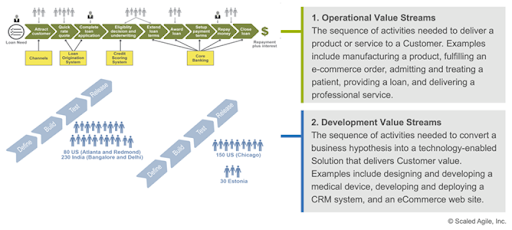
Identifying development value streams and understanding the flow through the organization is a vital step in improving value delivery.
Agile Release Trains, or ARTs, are virtual organizations that organize work around customer value for people.
ARTs align people to value streams to build or deliver the value stream’s products and services. They may or may not have a one-to-one relationship with value streams, depending on their size. They, however, provide a structured “team of teams” continually and steadily to support the values streams’ end goals.

Satyajit has broad and deep experience in Agile coaching at the strategic senior executive level while also coaching and uplifting the capability of teams and individuals. An Agile Coach and SAFe® Practice Consultant with more than 24 years of experience.
WhatsApp Us

We will get back to you soon!
For a detailed enquiry, please write to us at connect@agilemania.com

